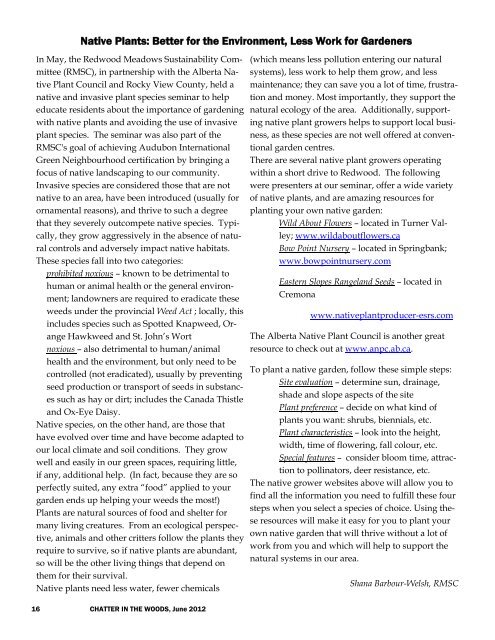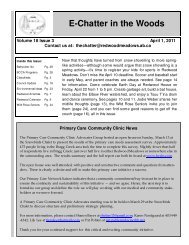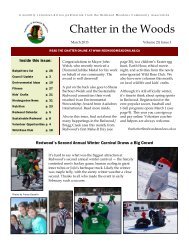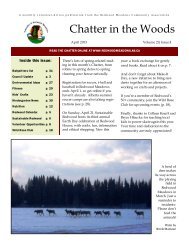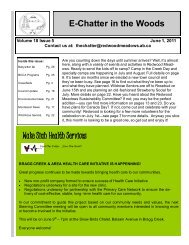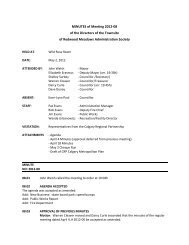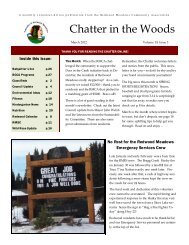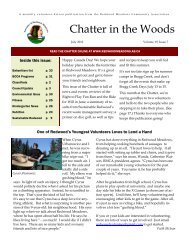Look for us in our new location soon! - Townsite of Redwood Meadows
Look for us in our new location soon! - Townsite of Redwood Meadows
Look for us in our new location soon! - Townsite of Redwood Meadows
Create successful ePaper yourself
Turn your PDF publications into a flip-book with our unique Google optimized e-Paper software.
Native Plants: Better <strong>for</strong> the Environment, Less Work <strong>for</strong> Gardeners<br />
In May, the <strong>Redwood</strong> <strong>Meadows</strong> S<strong>us</strong>ta<strong>in</strong>ability Committee<br />
(RMSC), <strong>in</strong> partnership with the Alberta Native<br />
Plant Council and Rocky View County, held a<br />
native and <strong>in</strong>vasive plant species sem<strong>in</strong>ar to help<br />
educate residents about the importance <strong>of</strong> garden<strong>in</strong>g<br />
with native plants and avoid<strong>in</strong>g the <strong>us</strong>e <strong>of</strong> <strong>in</strong>vasive<br />
plant species. The sem<strong>in</strong>ar was also part <strong>of</strong> the<br />
RMSC's goal <strong>of</strong> achiev<strong>in</strong>g Audubon International<br />
Green Neighb<strong>our</strong>hood certification by br<strong>in</strong>g<strong>in</strong>g a<br />
foc<strong>us</strong> <strong>of</strong> native landscap<strong>in</strong>g to <strong>our</strong> community.<br />
Invasive species are considered those that are not<br />
native to an area, have been <strong>in</strong>troduced (<strong>us</strong>ually <strong>for</strong><br />
ornamental reasons), and thrive to such a degree<br />
that they severely outcompete native species. Typically,<br />
they grow aggressively <strong>in</strong> the absence <strong>of</strong> natural<br />
controls and adversely impact native habitats.<br />
These species fall <strong>in</strong>to two categories:<br />
prohibited noxio<strong>us</strong> – known to be detrimental to<br />
human or animal health or the general environment;<br />
landowners are required to eradicate these<br />
weeds under the prov<strong>in</strong>cial Weed Act ; locally, this<br />
<strong>in</strong>cludes species such as Spotted Knapweed, Orange<br />
Hawkweed and St. John’s Wort<br />
noxio<strong>us</strong> – also detrimental to human/animal<br />
health and the environment, but only need to be<br />
controlled (not eradicated), <strong>us</strong>ually by prevent<strong>in</strong>g<br />
seed production or transport <strong>of</strong> seeds <strong>in</strong> substances<br />
such as hay or dirt; <strong>in</strong>cludes the Canada Thistle<br />
and Ox-Eye Daisy.<br />
Native species, on the other hand, are those that<br />
have evolved over time and have become adapted to<br />
<strong>our</strong> local climate and soil conditions. They grow<br />
well and easily <strong>in</strong> <strong>our</strong> green spaces, requir<strong>in</strong>g little,<br />
if any, additional help. (In fact, beca<strong>us</strong>e they are so<br />
perfectly suited, any extra “food” applied to y<strong>our</strong><br />
garden ends up help<strong>in</strong>g y<strong>our</strong> weeds the most!)<br />
Plants are natural s<strong>our</strong>ces <strong>of</strong> food and shelter <strong>for</strong><br />
many liv<strong>in</strong>g creatures. From an ecological perspective,<br />
animals and other critters follow the plants they<br />
require to survive, so if native plants are abundant,<br />
so will be the other liv<strong>in</strong>g th<strong>in</strong>gs that depend on<br />
them <strong>for</strong> their survival.<br />
Native plants need less water, fewer chemicals<br />
16 CHATTER IN THE WOODS, June 2012<br />
(which means less pollution enter<strong>in</strong>g <strong>our</strong> natural<br />
systems), less work to help them grow, and less<br />
ma<strong>in</strong>tenance; they can save you a lot <strong>of</strong> time, fr<strong>us</strong>tration<br />
and money. Most importantly, they support the<br />
natural ecology <strong>of</strong> the area. Additionally, support<strong>in</strong>g<br />
native plant growers helps to support local b<strong>us</strong><strong>in</strong>ess,<br />
as these species are not well <strong>of</strong>fered at conventional<br />
garden centres.<br />
There are several native plant growers operat<strong>in</strong>g<br />
with<strong>in</strong> a short drive to <strong>Redwood</strong>. The follow<strong>in</strong>g<br />
were presenters at <strong>our</strong> sem<strong>in</strong>ar, <strong>of</strong>fer a wide variety<br />
<strong>of</strong> native plants, and are amaz<strong>in</strong>g res<strong>our</strong>ces <strong>for</strong><br />
plant<strong>in</strong>g y<strong>our</strong> own native garden:<br />
Wild About Flowers – located <strong>in</strong> Turner Valley;<br />
www.wildaboutflowers.ca<br />
Bow Po<strong>in</strong>t Nursery – located <strong>in</strong> Spr<strong>in</strong>gbank;<br />
www.bowpo<strong>in</strong>tnursery.com<br />
Eastern Slopes Rangeland Seeds – located <strong>in</strong><br />
Cremona<br />
www.nativeplantproducer-esrs.com<br />
The Alberta Native Plant Council is another great<br />
res<strong>our</strong>ce to check out at www.anpc.ab.ca.<br />
To plant a native garden, follow these simple steps:<br />
Site evaluation – determ<strong>in</strong>e sun, dra<strong>in</strong>age,<br />
shade and slope aspects <strong>of</strong> the site<br />
Plant preference – decide on what k<strong>in</strong>d <strong>of</strong><br />
plants you want: shrubs, biennials, etc.<br />
Plant characteristics – look <strong>in</strong>to the height,<br />
width, time <strong>of</strong> flower<strong>in</strong>g, fall col<strong>our</strong>, etc.<br />
Special features – consider bloom time, attraction<br />
to poll<strong>in</strong>ators, deer resistance, etc.<br />
The native grower websites above will allow you to<br />
f<strong>in</strong>d all the <strong>in</strong><strong>for</strong>mation you need to fulfill these f<strong>our</strong><br />
steps when you select a species <strong>of</strong> choice. Us<strong>in</strong>g these<br />
res<strong>our</strong>ces will make it easy <strong>for</strong> you to plant y<strong>our</strong><br />
own native garden that will thrive without a lot <strong>of</strong><br />
work from you and which will help to support the<br />
natural systems <strong>in</strong> <strong>our</strong> area.<br />
Shana Barb<strong>our</strong>-Welsh, RMSC


